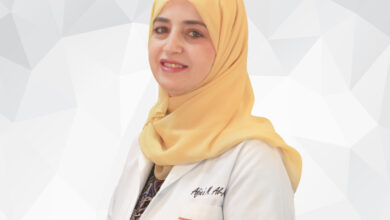Medical Informatics A story to be told

Professor Mukhtar Al-Hashimi
Ahlia University – Bahrain
Today, information and telecommunication technologies have tremendously impacted every discipline of our daily life. Reflecting on the state of healthcare over the last two decades, one can infer that the medical and healthcare sectors have been under pressure to meet their customer demand in an efficient and effective manner through adopting standards, and optimal clinical outcome with minimum cost. These challenges have facilitated the adoption of medical computing and acceptance of computer application in healthcare and medicine since 1990’s, resulting in the formulation of a new discipline known as “medical informatics.”
The literature introduces terminology such as Hospital or Health Information System, Clinical Information System (CIS), Patient Data Management System (PDMS), and Electronic Health Record (EHR). The Health Information Management Systems Society (HIMSS) views Electronic Health Records, EHRs as “A longitudinal electronic record of patient health information generated by one or more encounters in any care delivery setting including: patient demographics, progress notes, problems, medications, vital signs, past medical history, immunizations, laboratory data, and radiology reports.” Another definition for medical informatics come from Healthcare Information and Management Systems Society, “HIMSS” which define medical informatics as “the interdisciplinary study of the design, development, adoption and application of IT-based innovations in healthcare services delivery, management and planning.”
Today, medical informatics has revolutionized every aspect of healthcare process, leading to changes in the healthcare model from administrative, clinical functionalities, diagnostics, treatment, logistical and strategic planning, across the primary, secondary and tertiary healthcare bodies while extending the accessibility of patient information and resources across different innovative technologies such as clinical stations, handheld devices, and smartphones apps. Without a doubt, the advancement of medical informatics has reduced the administrative bottleneck, minimized the complexity of medical delivery, medical error and enhanced the medical decision support either through structure information, business intelligent, or automated clinical alert and protocol aimed to enhance the clinical outcome while reducing the cost of healthcare.
Since the early 1990s, healthcare leaders in Bahrain have envisioned the value of a patient care information system. Leaders planned to introduce a comprehensive patient care information system in a leading hospital in the country, with the emphasis on the lesson learned from previous international experiences and medical informatics. The author was given the opportunity to develop a comprehensive medical information system named AL-Care System. This project can be considered a pioneering experience of medical informatics in the country and was the brainchild of the author. The AL-Care System was successfully implemented and having the system resulted in the local and regional recognition of Bahrain’s experience in medical informatics that deserves to be shared. Accordingly, a vision for the AL-Care System has outlined around three dimensions of a patient-centric system:
- All design will center on the patient care process.
- Efficiency in every process and human interaction.
- Effectiveness in utilizing resources. Importantly the system should be economically feasible, integrate creative and innovative concepts, ideas, and technology that are applicable and timely for the users. Thus, the system success will inspire healthcare executive to adopt and recognize the importance of medical informatics for their healthcare setting.
Today’s healthcare system should be designed and built around patient needs in terms of clinical, administrative and financial aspects. In other words, the system should cover the activities chain involved across the healthcare’s internal and external boundaries. Once these needs have been met, it would be possible to achieve the strategic objective of MIS. Generally, the modules of MIS can be classified into clinical and non-clinical modules. The clinical modules focus on the core patient diagnostics and treatment activities designed to collect, store and manipulate data for the purpose of clinical assessment, and the director indirect decision-making process. There is a range of clinical modules, including patient clinical profile, laboratory, pharmacy, surgery, doctors’ orders, radiology, physiotherapy, clinical encounters, accident and emergency, and triage, besides the nursing and physician notes and discharge notes and follow-up.
Clinical modules will facilitate efficient data entry and retrieval, eliminate error and duplication through enforcing the quality control, standardize workflow and standard clinical protocols embedded within the clinical module while generating alert or clinical decision-making based on logic, statistics, data mining, and knowledge-based representation. As for the patient, administrative and support modules are aimed at automating these activities that support the healthcare provider with logistics and inventory, and patient need of hospitality services as well as patient admission and discharge. Another major group of modules is the patient billing and cost monitoring modules, along with the quality control modules.
At his point, is worth to elaborate on some of the clinical and non-clinical modules developed for the AL-Care system in order to provide a comprehensive snapshot of the MIS modules.

Patient Registration Module
The main objectives of the module are to add registration details of patients, to query registration details and to see the bed census. The Patient Registration Module is based on a unique patient identification number, which is assigned to each patient. Using the Registration module, the healthcare authorities can understand the distribution of their patients, categories, last admission and discharge dates along with other essential information such as admitting doctor, last chief complaint and discharge diagnosis, based on the International classification of diseases (ICD).
Clinic Appointment Module
This module comprises the appointments for the medical staff, private practice, and medical support facilities such as Laboratory, Physiotherapy and Radiology. Each appointment is linked to the actual attendance of the patient on the specific appointment date. This feature enables the decision-maker to plan manpower needs on the basis of patient load at a given time and period.
Clinical Profile Module
This module is designed to give the healthcare provider a quick snap-shot of the patient clinical status. It contains the following components for a given patient: clinical base parameters, allergy details, blood transfusions, drugs prescribed from different sources, family history details, existing disabilities, existing chronic diseases, surgery details and vaccination details. The clinical profile is the central clinical store for the healthcare provider in assessing the patient and family clinical status. The information from the clinical profile could be downloaded and stored on electronic chips, such as a Smart Card.
Doctor Station Module
The Doctor Station is a specially designed module to facilitate the clinical capabilities of doctors. Through this module, a doctor can see all diagnostic documents related to one patient without logging to different modules. Doctors can press any button such as Drugs, Surgery, Radiology, Lab results, etcetera. To view the related documents for that patient. This module is highly useful in a clinical environment.
Doctor Order Module
The Doctor Order module is intended to eliminate paperwork at the wards and to reduce prescription errors. It facilitates the doctors’ diagnoses and prescriptions for patients. By the implementation of this module, doctors are not required to write prescriptions on a piece of paper. They can enter the prescriptions through the computer. The doctors are provided with current pricing and stock levels of drugs, substitutes for unavailable medications, and possible interactions. The module results in quicker turnaround times for medications and better quality patient care. Voice messages can be sent to WhatsApp or SMS messages for medication reminders. Automatic refills are provided according to physician-specified refill instruction.
Physician Chart Module
The main aim of this module is to create clinical workstations, where a doctor views previous patient encounters for all clinics, leading to the elimination of patient files, saving money and retrieval time. It is based on international problem-oriented medical records, called SOAP. SOAP is divided into four components:
- Subjective – the patient presents complaint and history.
- Objective – the examination and other objective data
- Assessment – diagnosis or differential diagnosis.
- Plan – investigation and treatment. Physicians can enter the data either by typing the text, or using common templates designed to treat a certain disease, in addition to selecting the diagnosis code, visit outcome, and a number of leave days. The system provides an auditing and monitoring tool for quality improvements, as well as an educational and research tool, and understanding the distribution of diseases.
Surgical Module
The Surgical Module is a clinical-based system where information regarding surgeries done in the hospital is easily attained. The main features of the module are surgery requests, add procedures and add disposables. Each and every surgical procedure provided to patients are entered into the system. The system enables viewers to see how many operations performed by a doctor, by procedure, by a department, and by cost.
Laboratory Results
All lab results are now available in the MIS system. Lab results are divided into Microbiology results, Hematology results, Serology results, and Biochemistry and Histopathology results. All the lab machines are interfaced to AL-Care system and they send the results directly to the system, eliminating a lot of paperwork and saving time.
Pharmacy system
The pharmacy module was developed by incorporating desirable changes in the old system. The pharmacist can enter each prescription in the system by entering the patient number. After that, he can enter the drugs as per prescription. He can also select common dosage from the list provided. After finishing the entry, a label is printed for each medicine which contains the details about the patient, drug name, and instructions for the patient in both English and Arabic. This eliminates all manual jobs in the pharmacy in issuing drugs.
On a practical level, when implementing a medical information system in a healthcare organization, it is important to ensure that the system planning has to revolve around at least three strategic dimensions: cost leadership, efficient services, effective services and aligned to the strategic objectives of the organization while recognizing the potential value of each module and the organization readiness in term of resources, end-users competencies skills, implementation stage and both market competitiveness and cooperate strategy. It is important not to ignore the challenges that could arise from the implementation of a MIS, which could be lack of leadership support and end-users resistance to change. Finally, a healthcare organization should develop a strategy to plan and implement a medical information system to ensure return on investment.
















